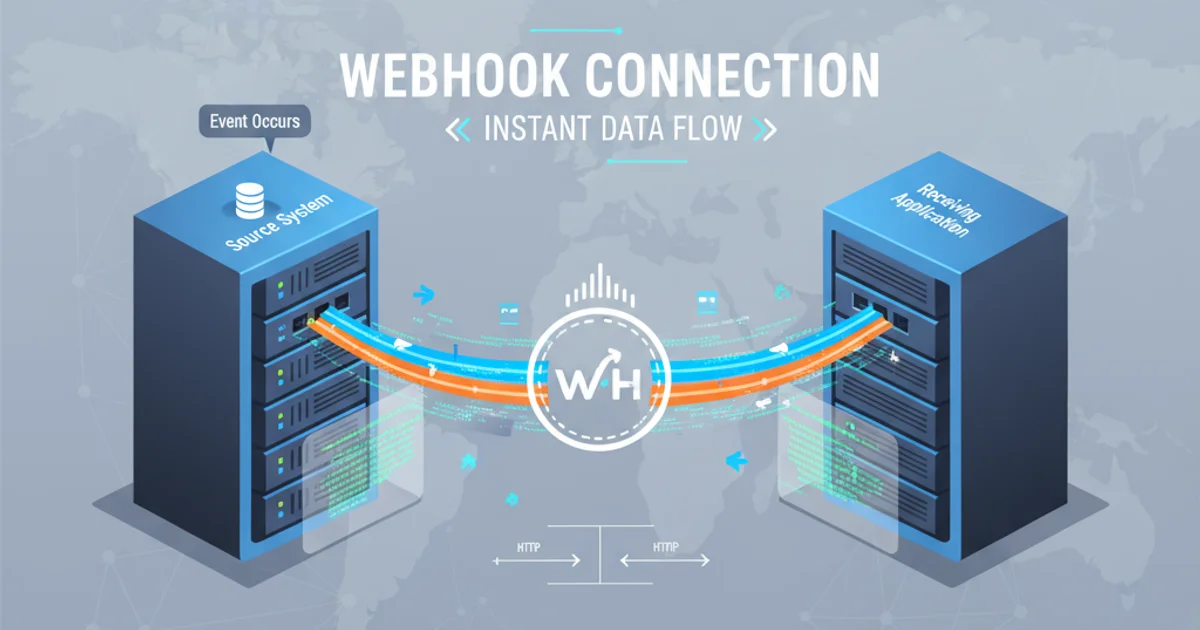What is a Webhook and why should I care?
Categories:
What is a Webhook and Why Should You Care?

Explore webhooks: how they enable real-time communication between applications, their benefits, and practical use cases for modern web development.
In the world of web development, efficient communication between different applications is paramount. While traditional API polling involves constantly asking a server for updates, webhooks offer a more elegant, real-time solution. Imagine a scenario where you don't have to keep checking your mailbox for new letters; instead, the post office calls you the moment a new letter arrives. That's essentially what a webhook does for your applications.
Understanding Webhooks: The Reverse API
At its core, a webhook is an automated message sent from an application when a specific event occurs. It's often described as a 'reverse API' because, instead of you making a request to an API, the API makes a request to your application. When an event happens in the source application (e.g., a new user signs up, an order is placed, a code commit is made), it sends an HTTP POST request to a pre-configured URL – your webhook endpoint. This request typically contains a payload of data about the event, usually in JSON or XML format.
sequenceDiagram
participant SourceApp as Source Application
participant YourApp as Your Application
SourceApp->>YourApp: 1. Event Occurs (e.g., New User)
YourApp->>SourceApp: 2. You register a Webhook URL
SourceApp-->>YourApp: 3. HTTP POST Request (Event Data)
YourApp->>YourApp: 4. Process Event Data
YourApp-->>SourceApp: 5. HTTP 200 OK (Acknowledgement)Sequence diagram illustrating the webhook communication flow.
Key Benefits of Using Webhooks
Webhooks provide significant advantages over traditional polling mechanisms, especially for applications requiring timely updates and efficient resource usage.
Here are the primary benefits:
- Real-time Updates: Webhooks deliver information instantly as events happen, enabling immediate reactions and synchronization between systems. This is crucial for applications like chat platforms, payment gateways, and CI/CD pipelines.
- Reduced Resource Usage: Unlike polling, which requires your application to repeatedly ask for updates (even when there are none), webhooks only send data when an event occurs. This saves bandwidth, API request quotas, and processing power for both the sender and receiver.
- Simplicity and Efficiency: Implementing webhooks can often be simpler than managing complex polling logic, especially when dealing with multiple event types or high-frequency updates. The event source handles the 'when' and 'what' of the notification.
- Extensibility: Webhooks allow you to extend the functionality of third-party services without needing to modify their core code. You can integrate custom logic into your application that responds to events from external platforms.
Common Use Cases for Webhooks
Webhooks are incredibly versatile and are used across a wide range of applications and services. Here are a few common examples:
- Payment Gateways (e.g., Stripe, PayPal): Receive instant notifications when a payment is successful, failed, or refunded, allowing you to update order statuses, send confirmation emails, or trigger fulfillment processes.
- Version Control Systems (e.g., GitHub, GitLab): Get alerts for code pushes, pull requests, or issue updates, which can trigger automated tests, deployments, or notifications to team members.
- Chat and Communication Platforms (e.g., Slack, Discord): Integrate custom bots or services that post messages in channels when specific events occur in other applications (e.g., a new support ticket, a server alert).
- CRM Systems (e.g., Salesforce): Synchronize customer data or trigger workflows in your application when a lead status changes or a new contact is added.
- E-commerce Platforms (e.g., Shopify): Update inventory, process orders, or send shipping notifications based on events like new orders, product updates, or customer registrations.
Implementing a Webhook Endpoint
To receive webhook notifications, your application needs to expose an HTTP endpoint that can accept POST requests. This endpoint will parse the incoming data and perform actions based on the event. Security is a critical concern when setting up webhooks, as you're exposing an endpoint to external services.
const express = require('express');
const bodyParser = require('body-parser');
const crypto = require('crypto');
const app = express();
const port = 3000;
// Use body-parser to parse JSON payloads
app.use(bodyParser.json());
// Your secret key for webhook verification (should be stored securely)
const WEBHOOK_SECRET = 'your_super_secret_key';
app.post('/webhook-listener', (req, res) => {
console.log('Webhook received!');
// --- Security: Verify the signature (example for GitHub-like webhooks) ---
const signature = req.headers['x-hub-signature-256'];
if (signature) {
const hmac = crypto.createHmac('sha256', WEBHOOK_SECRET);
const digest = 'sha256=' + hmac.update(JSON.stringify(req.body)).digest('hex');
if (digest !== signature) {
console.warn('Webhook signature mismatch!');
return res.status(401).send('Invalid signature');
}
} else {
console.warn('No webhook signature provided. Proceed with caution or reject.');
// Depending on your security requirements, you might reject requests without a signature
// return res.status(403).send('Signature required');
}
// --- End Security ---
const eventData = req.body;
console.log('Event Type:', eventData.event_type || 'Unknown');
console.log('Payload:', eventData);
// Process the event data here
// e.g., update a database, send an email, trigger another service
if (eventData.event_type === 'new_order') {
console.log(`New order received: ${eventData.order_id}`);
// Logic to process new order
} else if (eventData.event_type === 'user_signup') {
console.log(`New user signed up: ${eventData.user_email}`);
// Logic to welcome new user
}
// Acknowledge receipt of the webhook
res.status(200).send('Webhook received successfully!');
});
app.listen(port, () => {
console.log(`Webhook listener running at http://localhost:${port}`);
console.log('Register this URL (e.g., via ngrok) with your source application.');
});
A basic Node.js Express example for a webhook listener, including signature verification.
This example demonstrates a simple Node.js Express server acting as a webhook listener. It parses the incoming JSON payload and includes a basic signature verification step, which is crucial for ensuring the request originated from the expected source and hasn't been tampered with.
Conclusion: Embrace Event-Driven Architectures
Webhooks are a powerful tool for building responsive, efficient, and interconnected web applications. By shifting from a polling model to an event-driven notification system, you can significantly improve the performance, scalability, and real-time capabilities of your services. Understanding and effectively utilizing webhooks is a fundamental skill for any modern web developer looking to integrate with third-party services or build robust distributed systems. Embrace webhooks, and let your applications communicate smarter, not harder.